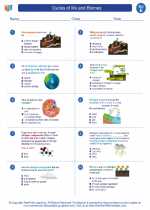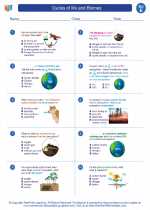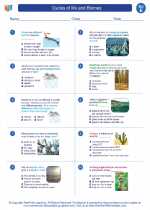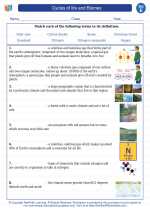Precipitation
Precipitation is a key part of the Earth's water cycle, where water in the atmosphere falls to the Earth's surface. This can occur in various forms, including rain, snow, sleet, and hail. Precipitation plays a crucial role in replenishing the Earth's freshwater resources and sustaining plant and animal life.
Types of Precipitation
- Rain: Liquid water droplets falling from the atmosphere to the Earth's surface.
- Snow: Ice crystals that form in the atmosphere and fall to the ground as snowflakes.
- Sleet: Frozen raindrops that partially melt as they fall through a layer of warm air, then refreeze as they reach the ground.
- Hail: Large, solid ice pellets that form within thunderstorms and are then dropped to the ground.
Formation of Precipitation
Precipitation forms when water vapor in the atmosphere condenses into liquid or solid droplets and becomes too heavy to remain suspended. This can occur through processes such as condensation, coalescence, and the freezing of water droplets in the atmosphere.
Factors Affecting Precipitation
Several factors can influence the type and amount of precipitation that falls in a particular area. These include:
- Temperature: Determines whether precipitation falls as rain, snow, sleet, or hail.
- Humidity: Higher humidity levels increase the likelihood of precipitation occurring.
- Wind patterns: Can transport moisture-laden air masses, influencing where precipitation occurs.
- Topography: Mountains and other land features can affect the distribution of precipitation.
Impacts of Precipitation
Precipitation has far-reaching impacts on the environment, agriculture, and human societies. It replenishes freshwater sources, nourishes crops, and sustains ecosystems. However, excessive or inadequate precipitation can lead to floods, droughts, and other natural disasters, impacting communities and economies.
Study Guide
To better understand the concept of precipitation, consider the following study guide questions:
- What is precipitation and how does it contribute to the water cycle?
- Describe the different types of precipitation and the conditions under which they form.
- Explain the processes involved in the formation of precipitation.
- Discuss the factors that influence the type and amount of precipitation in a given area.
- Explore the positive and negative impacts of precipitation on the environment and human activities.
By exploring these questions and concepts, you can gain a deeper understanding of the role that precipitation plays in shaping the Earth's systems and our daily lives.
.◂Science Worksheets and Study Guides Fifth Grade. Cycles of life and Biomes

 Worksheet/Answer key
Worksheet/Answer key
 Worksheet/Answer key
Worksheet/Answer key
 Worksheet/Answer key
Worksheet/Answer key
 Worksheet/Answer key
Worksheet/Answer key
 Vocabulary/Answer key
Vocabulary/Answer key
 Vocabulary/Answer key
Vocabulary/Answer key
